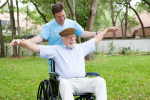针刀对膝骨性关节炎大鼠轴及软骨细胞自噬的影响
膝骨性关节炎(KOA)是退行性慢性关节疾病,主要临床表现为膝关节疼痛、僵硬、活动受限等。近年来,研究表明,膝关节周围软组织的损伤可导致软骨应力异常,关节软骨变性和破坏,软骨细胞减少,从而导致软骨退化。
针刀疗法以西医精细解剖、立体解剖及动态解剖理论为指导,融合了中医针灸疗法与西医手术刀的优势进行治疗,不仅能够利用针刀松解膝关节周围组织粘连,清除局部病变因素而恢复力学平衡,又可利用中医穴位的刺激作用而改善神经功能、缓解疼痛。
来自安徽中医药大学的杨等采用药物注射法制备大鼠KOA模型,探究针刀通过干预软骨细胞自噬改善KOA大鼠膝关节软骨损伤的作用机制。结果表明,针刀干预能明显改善KOA模型大鼠膝关节软骨损伤,降低mTOR的表达、提高Atg5、Atg12、Atg4a、ULK1、Beclin-1的表达。总之,针刀可以通过促进软骨细胞自噬恢复细胞稳态,进而改善关节软骨形态结构,延缓软骨细胞的衰老退变。
相关研究由杨永晖、卢曼、黄小双等完成。研究结果发表在《中国针灸》第42卷,第1期,2022年。
Effect of needle knife on mTOR/Atg/ULK1/Beclin-1 axis and chondrocyte autophagy in rats with knee osteoarthritis
Knee osteoarthritis (KOA) is a degenerative chronic joint disease, the main clinical manifestations of knee pain, stiffness, limited movement, etc. In recent years, studies have shown that damage to the soft tissues around the knee joint can lead to abnormal cartilage stress, degeneration and destruction of articular cartilage, and loss of chondrocytes, which can lead to cartilage degeneration.
Needle knife therapy is guided by western medicine, three-dimensional anatomical and dynamic anatomy theory. It integrates the advantages of acupuncture therapy of Traditional Chinese medicine and scalpel of Western medicine for treatment. It can not only use acupotomy to release the adhesion of tissues around the knee joint, remove local pathological factors and restore the mechanical balance, but also use the stimulation of acupuncture points of Traditional Chinese medicine to improve nerve function and relieve pain.
Yang et al. from Anhui University of Traditional Chinese Medicine prepared KOA rats by drug injection to explore the mechanism of acupotomology in improving knee cartilage injury in KOA rats by intervening chondrocyte autophagy. The results showed that needle knife intervention could significantly improve the knee cartilage injury in KOA rats, reduce the expression of mTOR and increase the expression of Atg5, Atg12, Atg4a, ULK1 and Beclin-1. In conclusion, needle knife can restore cell homeostasis by promoting chondrocyte autophagy, thus improving the morphology of articular cartilage and delaying the aging and degeneration of chondrocytes.
Related studies were completed by Yang Yong-hui, Lu Man and Huang Xiao-shuang. The results are published in Chinese Acupuncture & Moxibustion vol 42, No 1, 2022.













